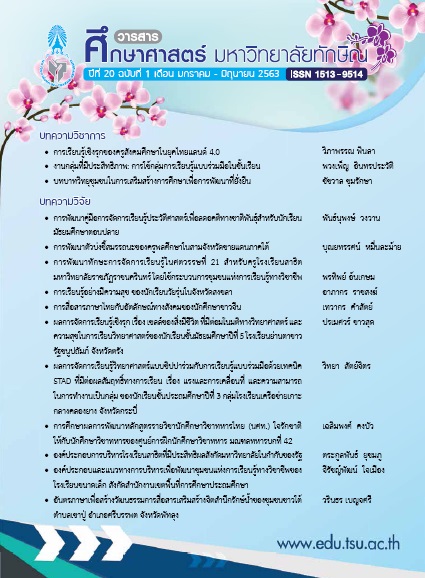อันตรภาษาเพื่อสร้างวัฒนธรรมการสื่อสารเสริมสร้างจิตสำนึกรักษ์น้ำของชุมชนชาวใต้ ตำบลเขาปู่ อำเภอศรีบรรพต จังหวัดพัทลุง
Main Article Content
บทคัดย่อ
การวิจัยครั้งนี้มีวัตถุประสงค์ (1) เพื่อพัฒนารูปแบบอันตรภาษาเพื่อสร้างวัฒนธรรมการสื่อสารเสริมสร้างจิตสำนึกรักษ์น้ำของชุมชนชาวใต้ ตำบลเขาปู่ อำเภอศรีบรรพต จังหวัดพัทลุง (2) เพื่อพัฒนาจิตสำนึกรักษ์น้ำของชุมชนชาวใต้ ตำบลเขาปู่ อำเภอศรีบรรพต จังหวัดพัทลุง ผลการวิจัยสรุปดังนี้ (1) รูปแบบอันตรภาษาเพื่อสร้างวัฒนธรรมการสื่อสารเสริมสร้างจิตสำนึกรักษ์น้ำของชุมชนชาวใต้ ตำบลเขาปู่ อำเภอศรีบรรพต จังหวัดพัทลุงเป็นอันตรภาษาที่มีการถ่ายโอนภาษา จากภาษาที่ 1 (L1) มาเป็นอันตรภาษา (IL) ร้อยละ 50 โดยที่รูปแบบอันตรภาษาของแต่ละคนโดยแตกต่างกัน (2) ระดับจิตสำนึกรักษ์น้ำของชาวเขาปู่หลังเข้าร่วมกิจกรรมอันตรภาษาเพื่อสร้างวัฒนธรรมการสื่อสารเสริมสร้างจิตสำนึกรักษ์น้ำของชุมชนชาวใต้ ตำบลเขาปู่ อำเภอศรีบรรพต จังหวัดพัทลุง สูงกว่าก่อนการเข้าร่วมกิจกรรม แตกต่างกันอย่างมีนัยสำคัญทางสถิติที่ระดับ .05
Article Details
ในกรณีที่กองบรรณาธิการ หรือผู้เชี่ยวชาญ ซึ่งได้รับเชิญให้เป็นผู้ตรวจบทความวิจัย หรือ บทความทางวิชาการมีความเห็นว่าควรแก้ไขความบกพร่อง ทางกองบรรณาธิการจะส่งต้นฉบับให้ ผู้เขียนพิจารณาจัดการแก้ไขให้เหมาะสมก่อนที่จะลงพิมพ์ ทั้งนี้ กองบรรณาธิการจะยึดถือความคิด เห็นของผู้เชี่ยวชาญเป็นเกณฑ์
เอกสารอ้างอิง
เกียรติคุณ ทิพย์พะยอม. (2546). การถ่ายโอนภาษาในการใช้อนุภาคบ่งสถานที่ของชาวใต้ไทยที่เรียนภาษาญี่ปุ่นชั้นต้น. วิทยานิพนธ์ศิลปศาสตรมหาบัณฑิต คณะศิลปศาสตร์ มหาวิทยาลัยธรรมศาสตร์.คณะกรรมการการศึกษาขั้นพื้นฐาน,สำนักงาน. (2551). แนวทางการนำมาตรฐานการศึกษาขั้นพื้นฐานสู่การปฏิบัติ. กรุงเทพฯ: โรงพิมพ์ชุมนุมสหกรณ์การเกษตรแห่งประเทศไทย จำกัด.
จินดา เอี่ยมไพลิน. (2546). การศึกษาภาวะแทรกซ้อนระดับเสียงในภาษาไทยมาตรฐานของคนจีนแต้จิ๋วในกรุงเทพฯ. วิทยานิพนธ์มหาบัณฑิต ศิลปศาสตร์ (ภาษาศาสตร์) บัณฑิตวิทยาลัย มหาวิทยาลัยมหิดล.
ธัญญรัตน์ ปาณะกุล. (2545). หัวข้อน่าสนใจทางภาษาศาสตร์: เปรียบเทียบหน้าที่ประโยคกรรมในภาษาไทยและภาษาอังกฤษ. กรุงเทพฯ: สำนักพิมพ์มหาวิทยาลัยรามคำแหง.
บวร ฉายาถวิล. (2537). การแปรของหน่วยเสียง /l/ ในตำแหน่งท้ายพยางค์ภาษาอังกฤษของนิสิตปีที่ 1คณะอักษรศาสตร์ จุฬาลงกรณ์มหาวิทยาลัย. ภาคนิพนธ์มหาบัณฑิต คณะอักษรศาสตร์ จุฬาลงกรณ์มหาวิทยาลัย.
บังอรรัตน์ ชัยจำรูญพันธุ์. (2545). การวิเคราะห์ข้อผิดพลาดและกลวิธีการแปล Anaphora ของนิสิตชั้นปีที่ 3 มหาวิทยาลัยบูรพา. วิทยานิพนธ์ศิลปศาสตรมหาบัณฑิต บัณฑิตวิทยาลัย มหาวิทยาลัยบูรพา.
ฤทัย พานิช. (2550). ปัญหาการใช้คำบุพบทของนักศึกษาสาขาวิชาภาษาอังกฤษ ชั้นปีที่ 2 หลักสูตรครุศาสตรบัณฑิต. รายงานผลวิจัยในชั้นเรียน ทุนอุดหนุนวิจัยจากงบบำรุงการศึกษา คณะศึกษาศาสตร์ มหาวิทยาลัยราชภัฏลำปาง ประจำปีงบประมาณ 2550.
วิสุทธิระ เนียมนาค. (2553). รายงานการวิจัยเรื่อง การศึกษาอันตรภาษาทางด้านการเปล่งเสียงพูดของนักศึกษาสาขาวิชาภาษาอังกฤษ ชั้นปีที่ 1 มหาวิทยาลัยราชภัฏลำปาง จากการวิเคราะห์เปรียบต่างระบบเสียงภาษาไทยถิ่นเหนือจังหวัดลำปางกับระบบเสียงภาษาอังกฤษ.ทุนอุดหนุนวิจัยจากงบบำรุงการศึกษา มหาวิทยาลัยราชภัฏลำปาง ประจำปีงบประมาณ 2552. (เอกสารอัดสำเนา).
สุวิไล เปรมศรีรัตน์. (2549). “สถานการณ์ทางภาษาในสังคมไทยกับความหลากหลายทางชาติพันธุ์”. วารสารภาษาและวัฒนธรรม, 25, 2 กรกฎาคม-ธันวาคม 2549. นครปฐม: สถาบันวิจัยภาษาและวัฒนธรรมเพื่อพัฒนาชนบท มหาวิทยาลัยมหิดล.
สุวิไล เปรมศรีรัตน์. (2552). โครงการภาษาและชาติพันธุ์ในประเทศไทย. กรุงเทพมหานคร: สำนักงานคณะกรรมการการศึกษาขั้นพื้นฐาน กระทรวงศึกษาธิการ.
อัจฉรา ชูพูล. (2553). การศึกษาความเข้าใจและความสามารถในการนำไปใช้จริงเกี่ยวกับประโยค[-te ageru] [-te kureru] [-te morau] ของผู้เรียนภาษาญี่ปุ่นชาวไทย. วิทยานิพนธ์ศิลปศาสตร มหาบัณฑิต คณะศิลปศาสตร์ มหาวิทยาลัยธรรมศาสตร์.
Bruce F., Ellen R., Joel W. (1980). An approach to conducting research on the acquisition of pragmatic competence in a second language. Newbury House Publishers, Inc.,: Rowley.
Blum-Kulka, S. J. House, & G.K. Kasper (eds.). (1989). Cross-cultural pragmatics: Requests and apologies.Norwood, NJ: Ablex Publishing Corporation.
Beebe, L.M. (1984). “Myths about Interlanguage phonology”. Interlanguage phonology. (pp. 165-175).
Brown, H. Douglas. (2000). Principles of language learning and teaching. New York: AddisonWesley Longman, Inc.
Brown, Penelope & Levinson, Stephen C. (1987). Politeness : Some Universals in Language Usage. Cambridge: Cambridge University Press.
Clahsen, H, and Muysken, P. (1989) ‘The UG paradox in L2 acquisition’, Second Language Research, 5, 1-29.
Cook, V., and Newson, M. (1996) Chomsky’s Universal Grammar: An introduction. Oxford:Blackwell.
Corder, S. P. (1967) "The significance of learner's errors." International Review of Applied Linguistic,s 5, 161-170.
Dulay, H., and Burt, M. (1975) ‘A new approach to discovering universal strategies of child second language acquisition’, in D. Dato (ed.) Developmental Psycholinguistics: Theory and Applications, Georgetown University Round Table on Languages and Linguistics. Washington: Georgetown University Press, 209-233
Ellis, Rod. (1997). Second Language Acquisition. Oxford: Oxford University Press.
Gass, Susan & Selinker, Larry. (eds). (2008). Second Language Acquisition: An Introductory Course. New York: Routledge / Taylor and Francis Group.
Jack C. Richard (1971). Social Factors, Interlanguage and Language Learning. Laval University, Quebec.
Kasper, Gabriele & Blum-Kulka, Shoshana. (1993). Interlanguage Pragmatics. New York: Oxford University Press.
Kasper, Gabriele & Dahl, Merete. (1991). Research Methods in Interlanguage Pragmatics: Studies in second language Center Technical Reports Series. Hawaii: University of Hawaii.
Kasper and S. Blum-Kulka. (2009) Interlanguage Pragmatics. New York: Oxford University Press.
Kavaliauskienë, Galina. (2009). Role of Mother Tongue in Learning English for Specific Purposes. Retrived on July 16, 2014,http://www.espworld.info/Articles_22/PDF/ROLE%20OF%20MOTHER%20TONGUE%20IN%20LEARNING%20ENGLISH%20 FOR%20SPECIFIC%20PURPOSES.pdf.
Kihlstrom, John F. (1984). Conscious, Subconscious, Unconscious : A Cognitive Perspective. In K. S. Bowers & D. Meichenbaum (eds.), The Unconscious Reconsidered. New York: Wiley.
Kintsch, W., & Greene, E. The role of culture specific schemata in the comprehension and recall of stories. Discourse Processes, 1978, 1, 1 - 13.
Krashen, Stephen & Terrell, Tracy D. (1982). Second Language Acquisition. Portsmouth, NH: Heinemann.
Lado, Robert. (1974). Linguistics across Cultures. The University of Michigan press.
Li, Fang-Kuei. (1960). A tentative classification of Tai dialects. In Stanley Diamond (editor), Culture in history: essays in honor of Paul Radin. New York: Columbia U.
Li, Fang-Kuei. (1977). A handbook of comparative Tai (Oceanic Linguistics special publication no.15). Honolulu: University Press of Hawaii.
Lindholm, K.J. (2000). Bilingual immersion education: Criteria for program development. In A. M. Padilla, H. H. Fairchild, & C. Valadez (Eds.), Bilingual Education: Issues and Strategies. Beverly Hills, CA: Sage Publications.
Odlin, Terence. 1989. Language Transfer, Cross-Linguistic Influence in Language Learning: The Cambridge Applied Linguistics Series. Cambridge: Cambridge University Press.
Olshtain, E. (1983). “Sociocultural competence and language transfer: the case of apology.” In S. Gass & L. Selinker (eds.), Language transfer in Language Learning, 232-249. Rowley, MA: Newbury House.
O'Grady, W. D., & Dobrovolsky, M. (1996). Contemporary linguistic analysis: An introduction. Toronto: Copp Clark.
Schmidt, R. (1993). Awareness and second language acquisition. Annual Review of Applied Linguistics, 13, 206-226.
Seliger, H. (1977) "Does practice make perfect? A study of interaction patterns and L2 competence." Language Learning 27, 264-278.
Selinker, L. (1986). “Second Language Acquisition: Contrastive Analysis, Error Analysis and Related Aspects”. Interlanguage. (pp. 173-196).
Tarone, Elaine E. (1987). “The Phonology of Interlanguage”. Interlanguage Phonology. (pp. 70-71).
Thomas, Jenny. (1983). Meaning in Interaction. London & New York: Longman Group Limited.
Thomas, Wayne P. and Virginal Collier . (1997). School Effectiveness for Language Minority Students. NCBE Resource Collection Series No. 9.: George Washington University.
Trosborg, Anna. (1995). Interlanguage Pragmatics: Requests, Complaint and Apologies. Berlin, New York: Mouton de Gruyter.
UNESCO. (2003). Education in a Multilingual World. France.
Walqui, A. (2006, January 30). Defining quality teaching for English learners: Principals and practices. Third Annual ACOE English Learner Conference--Advancing the Language and Literacy of English Learners.
Walsh, T. and K. Diller. (1981). 'Neurolinguistic considerations on the optimal age for Second language learning' in K. Diller (ed.): Individual Differences and Universals in Language Learning Aptitude. Rowley, Mass.: Newbury House.


